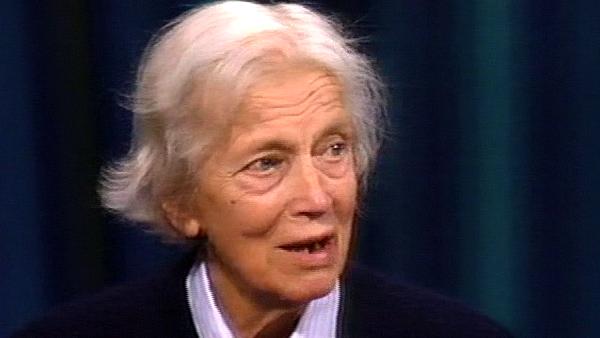NEXT STORY

Developing an early interest in science
RELATED STORIES

NEXT STORY

Developing an early interest in science
RELATED STORIES



|
Views | Duration | |
|---|---|---|---|
| 41. The upside-down molecular map of insulin | 133 | 06:12 |

The first three-dimensional maps of insulin in which we were sure that we knew how the molecule itself figured into the electron density, and that it composed this very pretty hexameric group of molecules fitting together.
[Q] Is that the zinc in the middle?
The quite interesting thing was the zinc in the middle. There were two zincs because there are six molecules, here the molecules are in three groups, two groups of three, one above the other.
Well, I had suggested to the Chinese they might try to make a heavy atom derivative of insulin and not surprisingly they did and they... after they'd given up my ideas about synthesising a heavy atom into it, they found that mercurials would make a heavy atom derivative with the histidine B5 of insulin. These are very much easier to interpret than the cadmium compounds or other compounds which we were working on in Oxford, and Liang Dong Cai who had come over to Oxford to work on proteins in order to set this programme of insulin going so he knew what state we were in, which was not a very good state at the time.
[Q] 1967, wasn't it?
Yes. And he was given all the facilities he needed by the Gang of Four who were as keen on insulin getting solved as any other person. He had a very large research group. We... I didn't. I heard of this by chance when I was visiting Vietnam and friends of mine visited Peking the same year, and they were expecting me to come there, and at that stage wherever were you, they had all these great models laid out ready for you this summer in Peking.
So I then discovered that they had solved the structure as well and I thought it tremendously important to see how closely our results agreed. So I made a plan to go to China the following year, which was the year we had the international crystallography conference in Japan, and relations with China weren't as good as I was hoping they would be. I was hoping I would get the Chinese to Japan, but I didn't manage to do that. But I did manage to compare completely our 2.8Å map, drawn up here, with their 2.6Å data map, and it was quite an amusing episode because I sent a message ahead of myself saying I will bring our map drawn to the scale of 1cm equal to 1Å, so you draw yours to the same scale and then we can easily see whether they're the same or different. And when I reached Peking Biophysics, I had a tremendously crowded lecture, and they were all obviously aware of the situation and quite critical and asking me detailed questions about what we did at various stages of our analysis and how well everything fitted. And I did the same by them, of course. And when we were sure we both were reliable investigators, we decided to compare the maps directly and we worked out the height at which they should coincide and took out the relevant sheets and put them together and to our horror, for a minute or two, they didn't fit. And then I thought, I mean this is an impossible situation, and I remembered that when the Royal Society had gone to China the year before and brought back photographs of the insulin model, their insulin model, Guy had said they've got the model upside down. Which only meant that they'd started their photography of insulin with the crystal upside down, so I then luckily turned my map which was on tracing paper upside down over theirs and immediately everything fitted quite well.
British pioneer of X-ray crystallography, Dorothy Hodgkin (1910-1994), is best known for her ground-breaking discovery of the structures of penicillin, insulin and vitamin B12. At age 18, she started studying chemistry at Somerville College, Oxford, then one of the University of Oxford colleges for women only. She also studied at the University of Cambridge under John Desmond Bernal, where she became aware of the potential of X-ray crystallography to determine the structure of proteins. Together with Sydney Brenner, Jack Dunitz, Leslie Orgel, and Beryl Oughton, she was one of the first people in April 1953 to see the model of the structure of DNA, constructed by Francis Crick and James Watson. She was awarded the 1964 Nobel Prize in Chemistry and is also known for her peace work with organisations such as Science for Peace and the Medical Aid Committee for Vietnam. All recorded material copyright of The Biochemical Society.
Title: The upside-down molecular map of insulin
Listeners: Guy Dodson
Guy Dodson studied chemistry and physical science at the University of New Zealand, followed by a PhD on the crystallographic study of an alkaloid. In 1961, he came to Oxford to work on the crystal structure of insulin. In the mid 1970s Guy and his wife moved to York University to establish a laboratory. In addition to insulin studies the laboratory has investigated many complex molecules of medical significance, including haemoglobin, myoglobin, HIV related proteins, proteases and proteins involved in managing nucleic acids in cells. In 1993, he went to the NIMR in London to establish a crystallographic group in an environment that spanned molecular, physiological and disease-related disciplines. Here his research began on some cell signalling proteins. His interests on medically relevant proteins included prions, malarial and TB proteins, and some clinically relevant thrombin inhibitors. Guy Dodson retired in 2004 but is still finding much to do in York and the NIMR.
Tags: China, Liang Dong Cai
Duration: 6 minutes, 12 seconds
Date story recorded: 1990
Date story went live: 02 June 2008